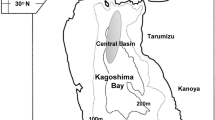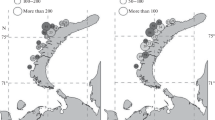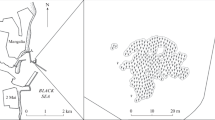Abstract
The changes in distribution and abundance of the barnacleBalanus rostranus that occurred at various sites of Amurskii Bay in 1982–1995 were studied. Increased water and sediment pollution by industrial and sewage discharge were found to most significantly affect the abundance of larvae, food composition, and the availability of substrata suitable for larva to settle. The mortality of young barnacles increased and the growth rate decreased in the most polluted areas of the bay at water temperatures higher than 18°C and at critically low oxygen saturation.
Similar content being viewed by others
References
Vashchenko, M.A. and Zhadan, G.V., Effect of Marine Pollution on the Reproduction of Common Marine Invertebrates,Biol. Morya, 1995, vol. 21, no. 6, pp. 369–377.
Vilenkin, V.Ya., Pertsov, N.A., Plotnikov, N.A., and Tsygankova, A.P.,In Vitro Control of the Growth Rate of Juveniles ofBalanus balanoides (Crustacea, Cirripedia),Zool. Zh., 1981, vol. 60, no. 10, pp. 1480–1485.
Zevina, G.B.,Biologiya morskogo obrastaniya (Biology of Marine Fouling), Moscow: Mos. Gos. Univ., 1994.
Konovalova, G.V., The Seasonal Characteristics of Phytoplankton in Amurskii Bay of the Japanese Sea,Okeanologiya, 1972, vol. 12, no. 1, pp. 123–128.
Korn, O.M., Reproductive Cycle of BarnacleBalanus rostratus in the Peter the Great Bay, the Sea of Japan,Biol. Morya, 1985, no. 3, pp. 36–43.
Korn, O.M., Long-term Variations of the Species Composition and Number of Larvae of Barnacles in Alekseyev Bight of Popov Island, the Sea of Japan,Biol. Morya, 1994, vol. 20, no. 2, pp. 100–106.
Lakin, G.F.,Biometriya (Biometrics), Moscow: Vysshaya Shkola, 1973.
Ovsyannikova, I.I. and Levin, V.S., Dynamics of Growth of BarnacleSolidobalanus hesperius on Shells of Japanese Scallop in Conditions of Bottom Rearing,Biol. Morya, 1982, no. 4, pp. 44–51.
Problemy khimicheskogo zagryazneniya vod mirovogo okeana (Problems of Chemical Pollution of Waters of the World Ocean), Vol. 4: Vliyaniye nefti i nefteproduktov ha mopskie organizmy i ikh soobshchestva (Effect of Oil on Marine Organisms and their Communities), Leningrad: Gidrometeeoizdat, 1985.
Savilov, A.I., Growth and its Variability of the White Sea Invertebrates:Mytilus edulis, Mya arenaria, andBalanus balanoides, Tr. IO AN SSSR, 1957, vol. 23, pp. 216–236
Silina, A.V., Determination of the Age and Growth rates of Japanese Scallop by the Surface Structure of its Shell,Biol. Morya, 1978, no. 5, pp. 29–39.
Silina, A.V. and Ovsyannikova, I.I., Long-term Variations in the Community of Japanese scallop and its Epibionts in the Polluted Part of Amurskii Bay of the Sea of Japan,Biol. Morya, 1995, vol. 21, no. 1, pp. 59–66.
Silina, A.V. and Ovsyannikova, I.I., Growth of BarnacleBalanus rostratus in the Sea of Japan,Biol. Morya, 1999, vol. 25, no. 1, pp. 19–23.
Stonik, I.V. and Orlova, T.Yu., Summer-Atumn Phytoplankton in Amurskii Bay of the Sea of Japan in a Eutrophic Environment,Biol. Morya, 1998, vol. 24, no. 4, pp. 205–211.
Chavtur, V.G., Yermakova, O.O., and Baranova, E.E., Preliminary Data on Plankton Composition and Distribution in Amurskii Bay, the Sea of Japan, Dept. Available from VINITI, 1992, Vladivostoks: IMB RAN, no. 2605–1392.
Shul'kin, V.M. and Borisovets, O.A., Heavy Metals in Bottom sediments of the East Part of Amurskii Bay (Sea of Japan), Available from VINITI, 1989, no. 6181-B89.
Barker, M.F., Culture and Morphology of Some New Zealand Barnacles (Crustacea: Cirripedia),N. Z. J. Mar. Freshwater Res., 1976, vol. 10, no. 1, pp. 139–158.
Barnes, H. and Barnes, M., The Growth Rate ofElminius modestus (Crust., Cirripedia) in Scotland,Int. Rev. Ges. Hydrobiol., 1962, vol. 47, no. 3, pp. 481–486.
Barnes, H. and Powell, H.T., The Growth ofBalanus balanoides (L). andB. crenatus Brug. under Varying Conditions of Submersion,J. Mar. Biol. Assoc. U.K., 1953, vol. 32, pp. 107–128.
Connell, J.H., The Consequences of Variation in Initial Settlement vs. Post-settlement Mortality in Rocky Intertidal Communities,J. Exp. Mar. Biol. Ecol., 1985, vol. 93, pp. 11–45.
Crisp, D.J., Factors Influencing Growth-Rate inBalanus balanoides, J. Anim. Ecol., 1960, vol. 29, pp. 95–116.
Crisp, D.J. and Bourget, E., Growth in Barnacles,Adv. Mar. Biol., 1985, vol. 22, pp. 199–244.
Gosselin, L.A. and Qian, P.-Y., Early Post-settlement Mortality of an Intertidal Barnacle: a Critical Period for Survival,Mar. Ecol. Progr. Ser., 1996, vol. 135, pp. 69–75.
Igic, Lj., The Barnacles as Epibionts on Edible Shellfish in the Northern Adriatic,Thalassia Jugosl., 1981, vol. 17, no. 1, pp. 31–54.
Kharlamenko, V.I., Zhukova, N.V., and Khotimchenko, S.V.,et al., Fatty Acids as Markers of Food Sources in a Shallow-water Hydrothermal Ecosystem (Kraternaya Bight, Yankich Island, Kurile Islands),Mar. Ecol. Progr. Ser., 1995, vol. 120, pp. 231–241.
Moore, D.G., The Biology ofBalanus balanoides, J. Mar. Biol. Assoc. U.K., 1935, vol. 20, no. 2, pp. 263–307.
Page, H.M., Differences in the Population Structure and Growth Rate of the Stalked BarnaclePollicipes polymerus between a Rocky Headland and an Offshore Oil Platform,Mar. Ecol. Prog. Ser., 1986, vol. 29, pp. 157–164.
Silina, A.V. and Ovsyannikova, I.I., Distribution of the BarnacleBalanus rostratus eurostratus near the Coasts of Primorye (Sea of Japan),Proc. Workshop Okhotsk Sea and Adjacent Areas: PICES Sci. Rept. 1996, no. 6, pp. 391–395.
Silina, A.V. and Ovsyannikova, I.I., BarnacleBalanus rostratus in the Northwestern Part of the Sea of Japan,Ophelia, 1998, vol. 49, no. 1, pp. 47–54.
Tkalin, A.V., Chlorinated Hydrocarbons in the Coastal Bottom Sediments of the Sea of Japan,Environ. Pollut., 1996, vol. 91, no. 2, pp. 183–185.
Tkalin, A.V., Belan, T.A. and, Shapovalov, E.N., The State of the Marine Environment near Vladivostok, Russia,Mar. Pollut. Bull., 1993, vol. 26, pp. 418–422.
Vermeij, G.J., Intraspecific Shore-level Site Gradients in Intertidal Molluscs,Ecology, 1972, vol. 53, pp. 693–700.
Author information
Authors and Affiliations
Rights and permissions
About this article
Cite this article
Silina, A.V., Ovsyannikova, I.I. Long-term and seasonal dynamics of the recruitment and growth of youngBalanus rostratus barnacles in Amurskii Bay, Sea of Japan. Russ J Mar Biol 26, 181–187 (2000). https://doi.org/10.1007/BF02759536
Accepted:
Issue Date:
DOI: https://doi.org/10.1007/BF02759536




